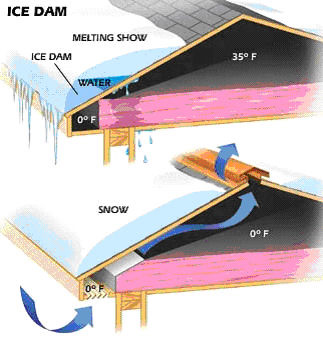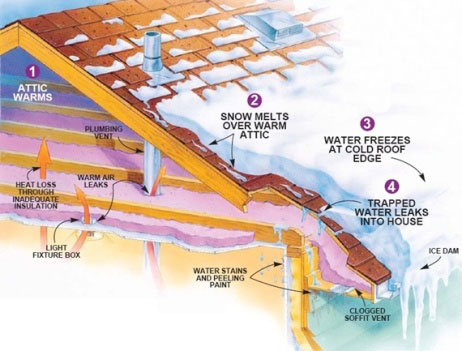Ice Dam Prevention Methods
Ice dams are the accumulated and persistent piles of ice and snow that can form along the edge of your roof – just above the gutter – and prevent the water from the snow that’s melting further up from reaching the gutter.  They form when the temperature of the roof along and above the eaves is significantly lower than the temperature further up. When that happens, the snow along the edge of the roof doesn’t melt as soon as the snow above it does. In the worst case, the snow along the eaves can not only slow down the water coming down the roof but cause it to re-freeze, creating a solid dam of ice. The water backed up behind that dam can then move under the shingles and through the underlayment into your attic, ceiling and walls.
They form when the temperature of the roof along and above the eaves is significantly lower than the temperature further up. When that happens, the snow along the edge of the roof doesn’t melt as soon as the snow above it does. In the worst case, the snow along the eaves can not only slow down the water coming down the roof but cause it to re-freeze, creating a solid dam of ice. The water backed up behind that dam can then move under the shingles and through the underlayment into your attic, ceiling and walls.
Ice dams are far easier to prevent than to remove. The fix is to tune up your attic ventilation so that the roof is pretty much the same temperature from fascia to ridge. You probably already have a ridge vent or gable vents. Given that, you need to focus on the intake end of the system, at the eaves. The operating image for solving the problem is “outside air must flow unimpeded above the attic insulation from the soffit to the ridge.”
ventilation so that the roof is pretty much the same temperature from fascia to ridge. You probably already have a ridge vent or gable vents. Given that, you need to focus on the intake end of the system, at the eaves. The operating image for solving the problem is “outside air must flow unimpeded above the attic insulation from the soffit to the ridge.”
First, make sure that there is no insulation outside the outside wall of your house or above the top plate of your exterior wall. All insulation should lie on top of the ceiling and none of it should touch the roof. This allows the ventilating air to circulate under the entire roof so that it will stay at the same temperature all over.
If it does not already exist, create a way for air to enter the attic through the soffit. Ideally, there should be an intake vent between each rafter tail. Better yet, you can replace the soffit board with material that has openings all along it, This provides a continuous intake vent. Depending on which you prefer, you should be able to buy small round vent screens that pop into holes you cut into your soffit with a hole saw at any decent building supply store, as well as the continuous vent material.
Finally, ensure that the outlet vents – along the ridge or high in the gable ends, are open and free of any obstruction that might slow down the air that is trying to get out.

